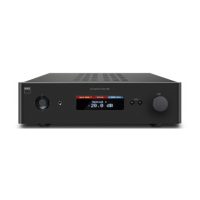
Do you have a question about the NAD C 368 and is the answer not in the manual?
| Damping factor | 200 |
|---|---|
| Frequency range | 10 - 85000 Hz |
| Signal-to-Noise Ratio (SNR) | 110 dB |
| Total Harmonic Distortion (THD) | 0.009 % |
| Dynamic power per channel (2 Ohm) | 260 W |
| Dynamic power per channel (4 Ohm) | 240 W |
| Dynamic power per channel (8 Ohm) | 145 W |
| RMS power output per channel (4 Ohm) | 80 W |
| Power consumption (standby) | 0.5 W |
| Digital audio coaxial in | 2 |
| Package weight | 10100 g |
| Product color | Black |
| Volume control | Rotary |
| Connectivity technology | Wired |
| Depth | 390 mm |
|---|---|
| Width | 435 mm |
| Height | 100 mm |
| Weight | 8600 g |
Basic safety and handling rules for operation, including reading and following instructions.
Covers cleaning, attachments, water safety, cart use, ventilation, and power cord protection.
Addresses power sources, lightning, power lines, overloading, and liquid entry risks.
Procedures for when the unit requires service or replacement parts.
Warnings against placing flames on the unit and high headphone volume.
Proper disposal of batteries and post-service safety confirmation.
Guidelines for wall/ceiling mounting and ventilation.
Explanation of safety symbols and recommended unit placement.
FCC rules for digital devices and information on recycling.
Instruction to note device identification numbers for future reference.
List of items packed with the NAD C 368 amplifier.
Advice on keeping packaging for safe transport or storage.
Guidance on selecting a suitable environment for the unit.
Procedure to reset the unit to its original factory configuration.
The power indicator light and standby button for power management.
Controls for menu navigation and the headphone output jack.
The unit's information screen and the infrared remote sensor.
Controls for choosing audio inputs and adjusting loudness.
Ports for connecting digital (Coax, Optical) and analog (Phono, Line) sources.
Output for pre-amplifier or subwoofer connection.
Ports for remote control signal input/output and external device triggers.
Terminals for speaker connection and configuration for mono operation.
AC power connection port and access to the internal fuse.
Power input, service port, and wireless antenna terminal.
Terminal for grounding and serial data port for PC control.
System's capability for modular expansion with upgrade cards.
HDMI input/output capabilities for video and audio pass-through.
Analog phono input and high-quality analog-to-digital conversion.
Connecting to network music services and advanced management.
Power, device selection, input selectors, mute, source, and dimming functions.
Adjusting loudness, selecting speakers, and activating tone controls.
Adjusting loudness level and selecting active speaker outputs.
Switching audio tone adjustments on or off.
Remote functions for controlling NAD CD players.
Remote functions for controlling NAD Tuners.
Managing music playback via the BluOS module.
Loading and resetting remote control library codes for different NAD products.
Mapping remote library codes to specific NAD product models.
How to enter and move through the unit's main menu options.
Enabling, naming, or disabling audio sources.
List of configurable system parameters available in the Settings menu.
Adjusting Bass, Treble, and Balance for audio output.
Detailed audio frequency tuning for Bass, Treble, and Balance.
Selecting which speaker outputs are active.
Adjusting the brightness level of the front panel display.
Configuring low-pass filters for bass redirection to a subwoofer.
Setting the function of the Pre-Out or Subwoofer terminals.
Setting automatic power-off timers for energy saving.
Enabling automatic wake-up from standby mode via input signals.
Managing remote interference with multiple NAD devices.
Programming the unit to learn remote control codes from other devices.
Updating software and viewing current firmware versions.
Checking installed Modular Design Construction (MDC) cards.
Pairing and connecting Bluetooth devices for audio playback.
Setting up network streaming, services, and rebooting the module.
Technical performance details for the preamplifier and speaker outputs.
Technical details for the phono stage and headphone jack.
Overall technical performance metrics and physical characteristics.